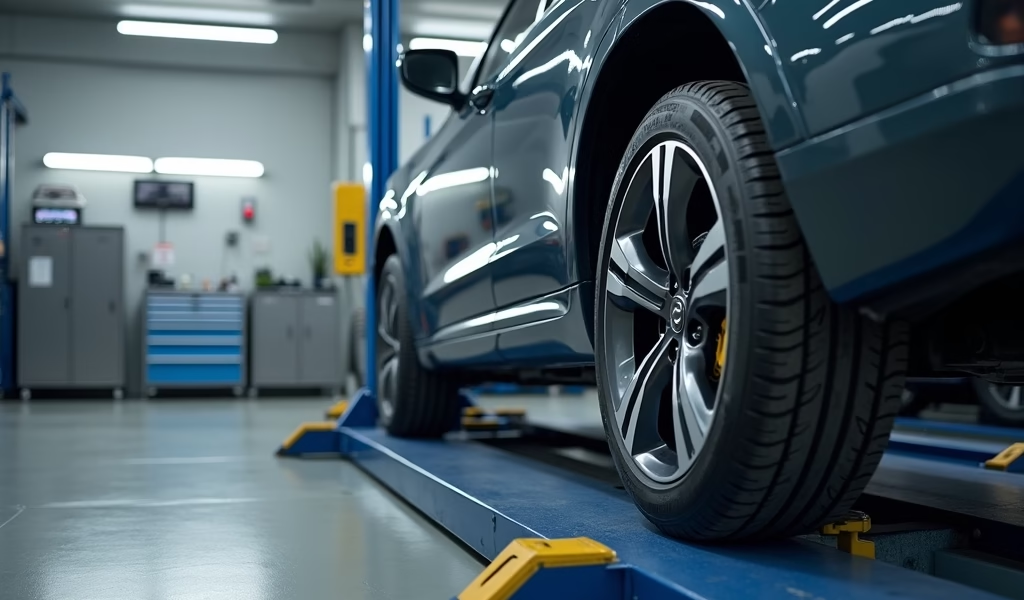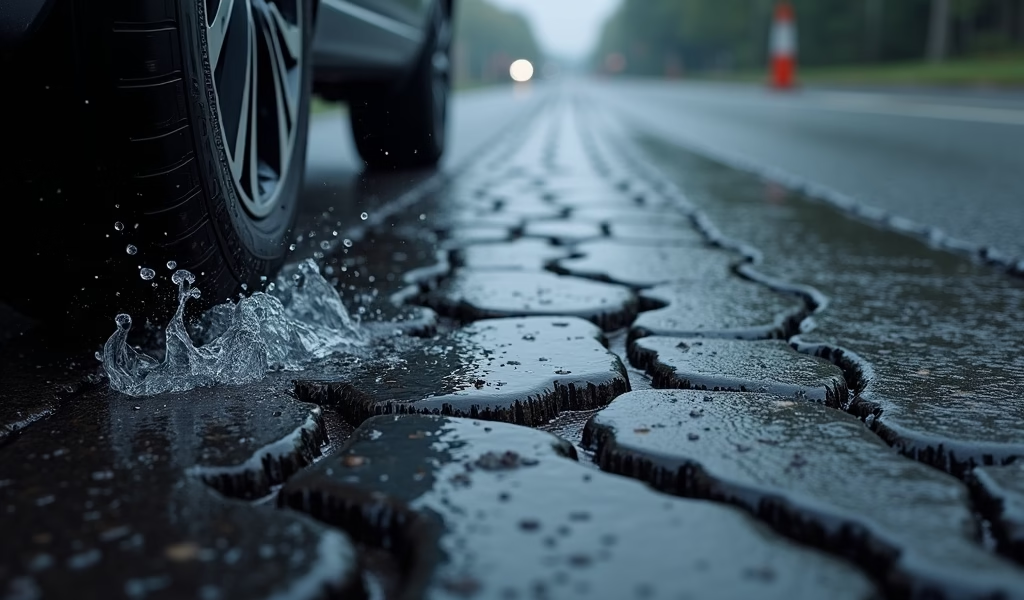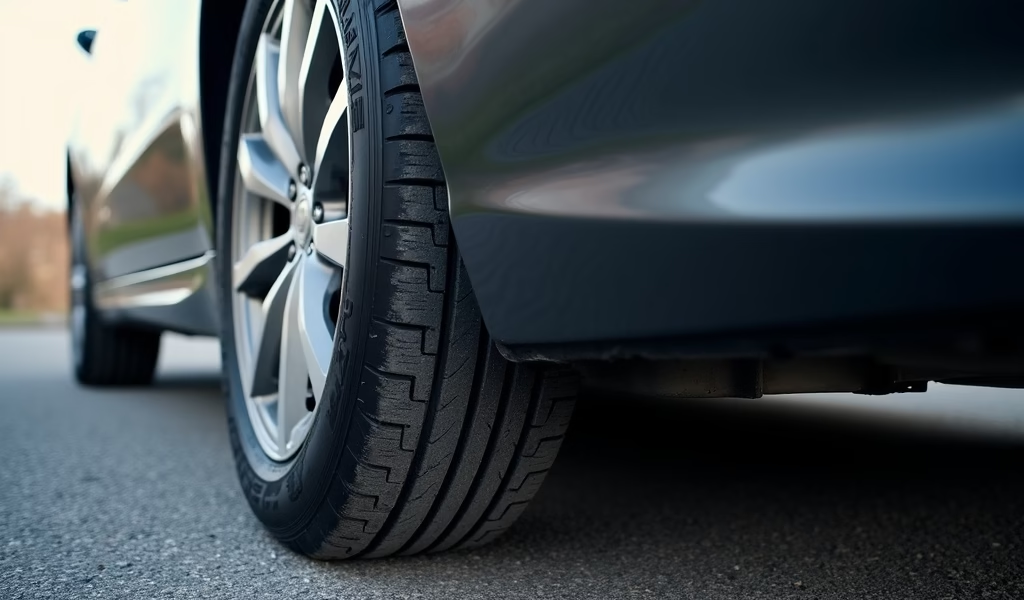Overview
This article explains how to monitor tire tread depth through built-in wear indicators, the penny test, and depth gauges, emphasizing that while 2/32 inch is the legal minimum, safety often requires greater depth. The author recommends monthly inspections and explains how uneven wear patterns can diagnose vehicle issues like misalignment or improper inflation, stressing that proper tire maintenance is crucial for vehicle safety.
Table of Contents
- Understanding Tread Wear Indicators
- The Penny Test Method
- Using a Tread Depth Gauge
- Legal and Safety Minimums
- Monitoring Uneven Wear Patterns
- Conclusion
- Frequently Asked Questions
When it comes to vehicle safety, your tires are literally where the rubber meets the road. Those small patches of rubber are all that connect your two-ton vehicle to the asphalt below, making tire health critical to your safety. The tread depth wear indicator is your tire’s built-in warning system, designed to let you know when it’s time for new tires before things get dangerous.
As a mechanic with over 15 years in the field, I’ve seen too many accidents that could have been prevented with proper tire maintenance. That’s why I’m sharing these five essential tips to help you understand and monitor your tire tread depth indicators. Your tires might not be the most exciting part of your vehicle, but they’re certainly among the most important.
Understanding Tread Wear Indicators
Tread wear indicators (TWIs) are small raised bars built into your tires during manufacturing. They’re not add-ons or aftermarket features—they come standard with every passenger tire made today. These unassuming rubber bars are positioned at the bottom of the tread grooves, typically sitting exactly 2/32 of an inch (1.6mm) from the bottom.
Finding these indicators is surprisingly simple. Look for small triangular markers along the tire’s sidewall, usually with the letters “TWI” next to them. These markers point to the exact locations of the wear bars across the tire’s circumference. You’ll typically find six to eight of these indicators spaced evenly around each tire.
The genius of this system is in its simplicity. When your tire tread wears down to the same level as these indicators, it means your tires have reached the legally mandated minimum depth. At this point, the bars become flush with the surrounding tread, creating a visible band that runs across the tire surface—nature’s way of saying, “Hey buddy, time for new tires!”
The purpose of tread depth isn’t just for better grip—though that’s certainly important. Proper tire tread pattern design and depth allow water to channel away from beneath your tire, preventing hydroplaning on wet roads. When these channels become too shallow, water can’t escape quickly enough, and you essentially start driving on a layer of water instead of the road.
The Penny Test Method

While tread wear indicators are built into every tire, sometimes you want a quick visual check without crawling around your car. Enter the penny test—a time-honored tradition among mechanics and car enthusiasts alike.
The penny test works because Abraham Lincoln’s head on a U.S. penny is almost exactly 2/32 of an inch from the edge of the coin to the top of his head. Convenient, right? Here’s how to perform this quick check:
- Take a penny and hold it with Lincoln’s head upside down, facing you
- Insert the penny into several different tread grooves across your tire
- Look at how much of Lincoln’s head disappears into the tread
- If you can see all of Lincoln’s head, your tires are worn to or below the 2/32″ minimum
- If part of his head is covered by the tread, you still have some life left
I recommend checking multiple spots on each tire, including both edges and the center. Tires often wear unevenly, and checking just one spot might not tell the whole story. Think of it like testing the temperature of a chicken—you wouldn’t just check one spot and call it done.
While the penny test is a good starting point, it only tells you if you’re at or below the legal minimum. For better safety, especially in wet conditions, many professionals (including myself) recommend using a quarter instead. If the tread reaches Washington’s head on a quarter, you have about 4/32 of an inch—a much safer depth for rainy conditions according to NHTSA tire safety guidelines.
Using a Tread Depth Gauge
While the penny test works in a pinch, nothing beats the precision of a proper tread depth gauge. These affordable tools (usually under $10) provide exact measurements that take the guesswork out of tire maintenance.
A basic tread depth gauge looks a bit like a small probe or measuring stick. The base rests on the tire’s surface, and a probe extends into the tread groove. The measurement is displayed either on a simple scale or, for digital versions, on an LCD screen.
To use a tread depth gauge properly:
- Make sure your tire is on a flat surface and your vehicle is securely parked
- Place the base of the gauge firmly on the tire tread surface
- Push the probe down until it reaches the bottom of the tread groove
- Read the measurement (in 32nds of an inch or millimeters, depending on your gauge)
- Repeat this process in at least three spots across the width of each tire
I’ve found that taking measurements in multiple places—outer edge, center, and inner edge—gives the most complete picture of tire wear. This practice has helped me identify alignment issues early, potentially saving my customers hundreds in premature tire replacement.
For the data-lovers among us, digital gauges offer the most precise readings. Some even connect to smartphone apps that track your tread wear over time. According to Consumer Reports, regular monitoring with a precise gauge is one of the most effective ways to maximize tire life while maintaining safety.
Legal and Safety Minimums
When it comes to tread depth, there’s a significant difference between what’s legal and what’s safe. The legal minimum in most states is 2/32 of an inch (1.6mm)—that’s where those built-in wear indicators sit. But just because something’s legal doesn’t mean it’s optimal for safety.
In my years working as a mechanic, I’ve developed a more conservative approach to tread depth recommendations:
- 6/32″ and above: Excellent condition, suitable for all weather conditions including heavy rain and light snow
- 5/32″ to 4/32″: Good for normal and rainy conditions, but reduced performance in heavy rain and unsafe for snow
- 3/32″: Approaching replacement level, significantly reduced wet performance
- 2/32″: Minimum legal limit—replace immediately
The difference in stopping distance between new tires and those at the legal minimum is eye-opening. Tests conducted by independent safety organizations have found that stopping distances on wet roads can increase by up to 87 feet—that’s nearly six car lengths—when comparing new tires to those worn to the legal minimum.
I always tell my customers to think about tread depth based on their typical driving conditions. If you live in Seattle or Portland where it rains constantly, replacing at 4/32″ makes sense. If you’re dealing with snow in Colorado or Minnesota, you might want to consider winter tires once your all-seasons drop below 6/32″.
Remember, the legal minimum exists as an absolute floor, not a recommendation for optimal safety. As Tire Rack’s research has consistently shown, tire performance—especially in adverse conditions—begins declining long before you reach that 2/32″ threshold.
Monitoring Uneven Wear Patterns

Even if your overall tread depth is adequate, uneven wear patterns can tell you something’s wrong with your vehicle. Your tires are like four rubber diagnosticians, constantly collecting and displaying information about your car’s health.
Here are the most common wear patterns I see in my shop and what they typically indicate:
- Center wear: The middle of your tire is wearing faster than the edges, usually indicating overinflation. Your tire is bulging in the center, causing only this portion to contact the road.
- Edge wear (both sides): Both outer edges are wearing faster than the center, suggesting underinflation. The tire is sagging, making more contact with its shoulders than its center.
- One-sided wear: If only one edge (inner or outer) is wearing down, you’re likely dealing with an alignment issue. This is often accompanied by pulling to one side while driving.
- Cupping or scalloping: Tire surface has dips and scallops, indicating worn suspension components or wheels that need balancing.
- Feathering: Tread blocks feel smooth on one side and sharp on the other when you run your hand across them, suggesting improper toe alignment.
When checking your tires, don’t just look—feel them too. Run your hand across the tread in both directions. Ideally, the tire should feel equally smooth (or equally rough) in both directions. If it feels noticeably different one way versus the other, something’s likely out of alignment.
Regular tire rotations help distribute wear more evenly, but they won’t fix underlying problems. If you notice uneven wear patterns developing, don’t wait until your next scheduled maintenance. Get your vehicle checked right away. A simple alignment can save you hundreds in premature tire replacements.
I’ve seen countless customers who thought they needed new tires when what they really needed was an alignment or suspension work. By addressing the root cause first, you’ll not only save money but also prevent the same issue from ruining your next set of tires.
Conclusion
Your tires’ tread depth wear indicators are like the canaries in the coal mine of vehicle safety—they provide early warnings before a situation becomes dangerous. By understanding how to read these indicators and supplementing with tools like the penny test and a proper depth gauge, you’re taking control of one of the most critical safety aspects of your vehicle.
Remember that the legal minimum of 2/32″ is just that—a minimum. For optimal safety, especially in challenging weather conditions, maintain deeper treads. Your tires aren’t just about avoiding tickets or passing inspections; they’re about keeping you and your passengers safe on every journey.
Make checking your tread depth a regular part of your vehicle maintenance routine—at least once a month and before any long trips. A quick inspection today could prevent an emergency tomorrow. Your tires quite literally carry the weight of your safety on the road. Give them the attention they deserve.
Frequently Asked Questions
What exactly is a tread depth wear indicator?
A tread depth wear indicator is a raised rubber bar built into tire grooves during manufacturing. It becomes flush with the tread surface when the tire wears down to the legal minimum of 2/32 inch, signaling it’s time for replacement.
How often should I check my tire tread depth?
Check your tire tread depth at least once a month and before long road trips. Regular inspection helps catch excessive wear before it compromises safety.
Can I drive with tires at the minimum legal tread depth?
While legally permissible, driving with tires at the minimum 2/32″ tread depth significantly reduces performance, especially in wet conditions. For safety, consider replacement before reaching this minimum.
Do winter tires have different tread depth requirements?
Yes, winter tires require deeper tread to effectively handle snow and ice. Most experts recommend at least 6/32″ of tread depth for winter driving conditions.
Why do my tires wear unevenly even with regular rotation?
Uneven wear despite rotation usually indicates alignment issues, improper inflation, or worn suspension components. These underlying problems should be addressed by a professional to prevent premature tire wear.

